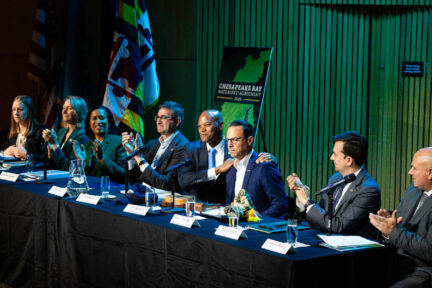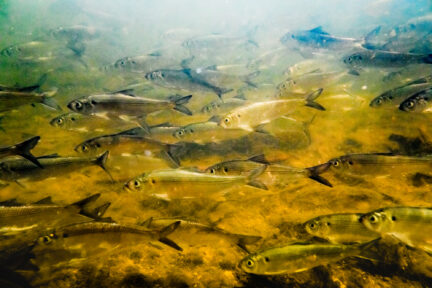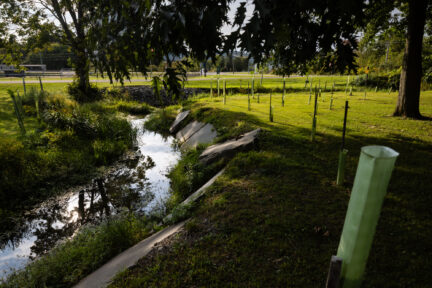Chesapeake Executive Council Increases Government Accountability and Improves Coordination By Launc
Chesapeake Executive Council Increases Government Accountability and Improves Coordination By Launc
The Chesapeake Executive Council today launched ChesapeakeStat, an innovative online tool to increase government accountability and improve coordination of restoration activities by transparently presenting comprehensive information about Chesapeake Bay Program (CBP) activities, funding and progress toward goals. Visit the site at http://stat.chesapeakebay.net.
Council members and executives in attendance – including U.S. Environmental Protection Agency Deputy Administrator Robert Perciasepe, Maryland Governor Martin O’Malley, Virginia Governor Bob McDonnell, Chesapeake Bay Commission Chairman Senator Mac Middleton, District of Columbia Mayor Adrian Fenty, and representatives from U.S. Department of Agriculture (USDA), New York, West Virginia, and Delaware – also discussed on-the-ground and in-the-water restoration activities during the past year. Since the Executive Council meeting in May 2009, CBP partners have worked toward meeting short-term goals for implementing pollution controls, with the first deadline for the two-year milestones fast approaching on December 31, 2011.
The Executive Council establishes the policy agenda for the Chesapeake Bay Program and is represented by leaders from the U.S. EPA, USDA, Maryland, Virginia, Pennsylvania, New York, Delaware, West Virginia, the District of Columbia, and the Chesapeake Bay Commission.
The 2010 Executive Council annual meeting was held in Baltimore at Living Classrooms Foundation facilities, where members spent part of the afternoon with Baltimore students restoring a wetland by planting vegetation, removing trash and constructing “floating islands” of wetlands. The Executive Council chose this location to highlight the need to connect communities to waterways, particularly in urban areas, and support restoration efforts of local governments, organizations and citizens. The Living Classrooms Foundation’s programs engage young people in stewardship of the environment and provide them with green skills for the future.
“We’ve initiated a new era defined by bold action and unparalleled levels of accountability. ChesapeakeStat will be instrumental in ensuring nothing short of real, measurable results,” said EPA Deputy Administrator Bob Perciasepe. “This is the most comprehensive and creative protection effort launched in years. We’re matching the challenge of this cleanup with the expanded efforts and additional resources at all levels of the government.”
The Executive Council also unveiled the first version of ChesapeakeStat, a new online tool to improve coordination of the restoration effort and provide transparency in government activities. ChesapeakeStat allows CBP managers, federal agencies, states, local governments, non-governmental organizations and the public to use the same information to track and plan restoration. The CBP will test the value of using ChesapeakeStat as a platform for highlighting local restoration activities. Photos can be entered and watershed organizations can be located on a map, and the public can submit ideas for how the website can improve with additional information.
Governor O’Malley’s BayStat provided the inspiration and model for ChesapeakeStat, and Maryland officials will help CBP partners to best utilize the site. This is the first version of ChesapeakeStat and it will be improved and evolved in an open and transparent way.
“Since 2007, Baystat has proven a powerful tool in Maryland for assessing, coordinating, targeting and accelerating our Bay restoration and conservation programs. It gives Maryland citizens the transparency they deserve, and forces us to be accountable to our commitments," said Governor Martin O'Malley. "With Administrator Jackson’s leadership, ChesapeakeStat can provide these same critical benefits."
In addition to launching ChesapeakeStat, CBP partners discussed restoration work undertaken since the May 2009 meeting and progress on the Chesapeake Total Maximum Daily Load (TMDL). CBP partners have worked during the past year to develop the Bay TMDL, which is a tool of the Clean Water Act that, when completed in December 2010, will be the most comprehensive “pollution diet” ever in the watershed and will include rigorous accountability for all levels of government, sources of pollution and stakeholders. States are currently developing detailed plans to meet TMDL pollution limits, with draft plans due September 1 and final plans due November 1.
“The policies and practices we adopt in the states and localities that make up the Chesapeake Bay watershed will have a significant impact on the health and vitality of this national treasure,“ stated Governor McDonnell. “That is one of the reasons I am committed to conserving an additional 400,000 acres of open space in the Commonwealth over the next four years. And it is why I’m looking forward to working closely with my fellow members of the Chesapeake Executive Council in the years ahead.”
“At the end of the day, the Bay’s health will be decided by the efforts of the individual – every farmer, every community leader, every property owner, every student. One at a time and collectively, everyone needs to help,” said Maryland State Senator Thomas “Mac” McLain Middleton, Chairman of the Chesapeake Bay Commission.



